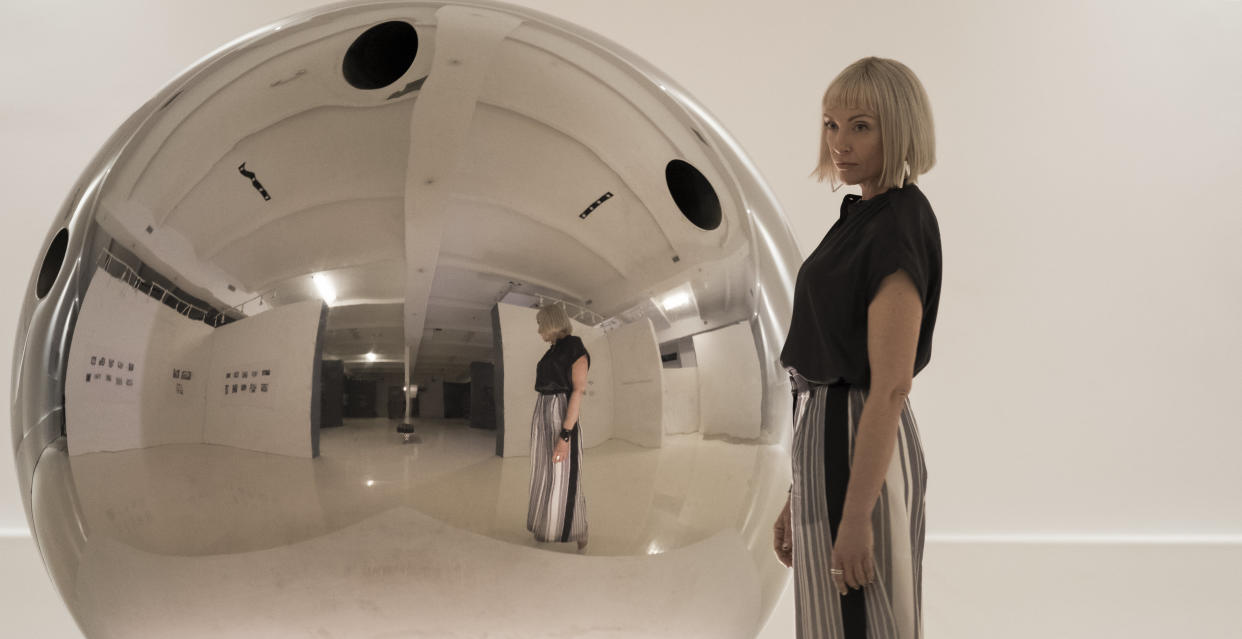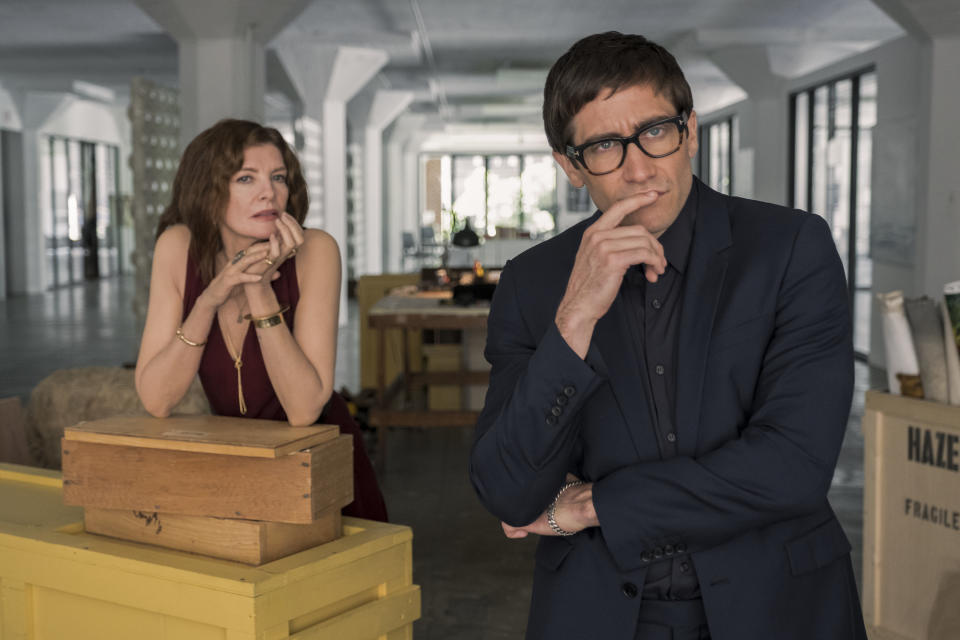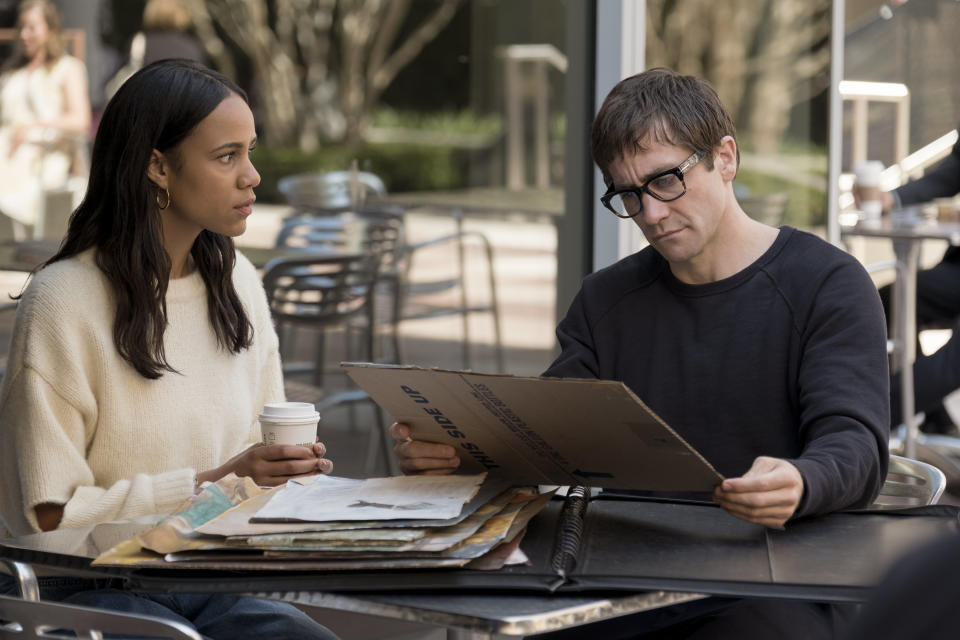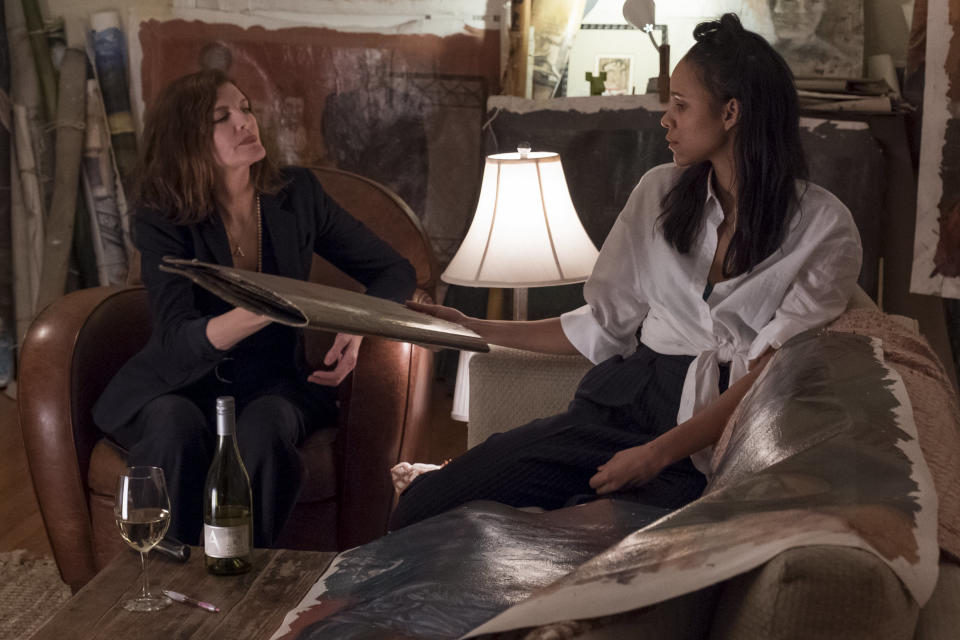Why The Satirical Slasher 'Velvet Buzzsaw' Has The Art World Screaming

The contemporary art world is a cutthroat place in “Velvet Buzzsaw,” the satire-horror mashup that premiered last week on Netflix. It’s also a cut-arm and a cut-neck place, if you’re being picky.
Written and directed by Dan Gilroy, “Buzzsaw” follows an interconnected circle of art world insiders peddling six-figure “perceptions” by any means necessary. “None of this is new,” says Rhodora Haze (Rene Russo), an anarchist/blue chip gallery owner with a perfectly cynical outlook on her profession. “It’s all been done since someone charged a bone to see the first cave painting.”
None of this (poking fun at the art world’s vacuousness and greed) is new either, until the plot of “Velvet Buzzsaw” takes a bloody turn. Josephina (Zawe Ashton), one of Rhodora’s associates, is the first to discover her neighbor’s corpse, simultaneously stumbling upon a trove of sinister paintings he left behind. The mysterious artist ― Vetril Dease ― then skyrockets to posthumous superstardom, with every character in Gilroy’s film hungry to get a piece of his pie.
The one problem? The artist was also a deranged murderer who really, really didn’t want his work seen or sold after his death. Naturally, his spirit haunts those who betray his wishes, hunting down every last one of our money-grubbing power players in a variety of creative ways.
The admittedly bizarre movie was not a hit among people in the real-life art world. Artist Katya Grokhovsky, in an email to HuffPost, described it as a cheap shot at “an easy target. ... I think the oversimplification of the art-people’s lives, passions and realities does not sit right with any of us.” Asked about his own art world horror stories, gallerist Frank Maresca responded, “The hour and a half that I spent viewing ‘Velvet Buzzsaw.’”
But the movie has its devotees, including HuffPost’s Priscilla Frank. She sat down with colleague Matt Jacobs, who isn’t as enthusiastic, to talk about the film’s successes and failures. They both wish they sounded more like the film’s central character, art critic Morf Vandewalt, while doing so.

Priscilla: Matt, darling, let’s talk “Velvet Buzzsaw,” the satire-slasher film that skewers the Los Angeles contemporary art scene as it quite literally mauls its inhabitants. The movie aimed to provide alternating scares and laughs. Did you find it successful in either or both of those arenas?
Matt: You know what? I can’t say I did. Which is a shame, because the only thing I love more than a good old-fashioned satire is a good old-fashioned slasher. But as clever as the premise may be, “Velvet Buzzsaw” felt a bit like the world it’s attempting to lampoon: hollow and redundant. Maybe that’s the point, but the movie lost me along the way. I hope you loved it, though. Did you love it?
Priscilla: I DID LOVE IT, I must say, although I wouldn’t necessarily disagree with your assessment of it being hollow and redundant. The movie reminded me of B-grade erotic thrillers of the 1980s and ’90s, which are some of my favorite movies of all time. I wish it were a bit scarier, but I enjoyed being able to watch it without getting the full-body cramp-up of being actually frightened. Ultimately, there’s something delicious about seeing the highbrow, precious, often pretentious art world molded into a trashy movie ― something so campy, lowbrow and purposefully in poor taste. The movie’s lacklusterness seemed like the real barbed insult against the art world it depicted, more than the two-dimensional caricatures and snarky one-liners.
That being said, I could watch Jake Gyllenhaal play Morf Vandewalt all day and all night. Especially if he is typing naked on his laptop. What did you think of his role — and his name?

Matt: OK, now you have my attention, partly because that’s the most trenchant defense of the movie I’ve heard so far and partly because you mentioned Gyllenhaal playing a snob named Morf Vandewalt. Morf!
I love Gyllenhaal. He is, without a doubt, one of this century’s best leading men. And this is Gyllenhaal in his finest form: zany, kitschy, a little ridiculous. The post-“Nightcrawler” phase of his career, in which he has essentially renounced the serious-actor reputation that followed him for years, is like manna for me.
Watching Gyllenhaal explode in a movie is like catharsis, given how many withdrawn loners he has played over the years. Finally, his freak flag is flying. And I like the way Morf (lol) is rendered. He is performing snobbery and spouting boilerplate critical lingo, expecting everyone to hang on his every highfalutin word. (Morf ― Morf!!! ― probably wouldn’t get along with Johnny Wilcox, Gyllenhaal’s “Okja” character, and that’s a huge compliment.) But I wish the movie around him could keep up. By the time the characters are getting plucked off one by one, “Final Destination” style, it’s as if the movie exchanges its bite for a soft gnash.
You know the art world far better than I. Is Morf as familiar as he seems?
Priscilla: Of all the far-fetched parts of this movie, Morf’s character, I think, is the most outlandish. Except, I guess, for the demonic murderer/painter. In “Velvet Buzzsaw,” the art world revolves around Morf, with his fancy apartment and bonkers art collection. He is a god, with the power to make or break an artist or institution with the power of his haute takes. But in reality, as much as I wish it were true, critics are not the power players in the art world equation.
I asked New York magazine critic Jerry Saltz about this, because in an interview, Gyllenhaal said he based much of his character on Saltz. He responded, “It strikes me as funny that a movie would have an art critic who supposedly has any power, sway or even say over prices and who’s who. And that apparently this critic seems to make money. Hah! At a time when art critics are fighting for their lives ― individually and as a profession ― and are paid next to nothing and the market is ascendant.”
However, to challenge that a little bit, I also spoke to Scott Ogden, who runs Shrine Gallery in New York City, and he said, “I do think Jerry holds more power than he admits or even realizes. I had a very quiet show, and he posted about it on Instagram, and it really blew up. There are people, like him, who have this air of celebrity that people react to.”
Overall, I think few critics IRL have the authority, ego and bank account that our dear Morf does.

Matt: The Saltz comparison is fascinating because I always think of Jerry Saltz as someone who does a good job of not speaking in the sort of ostentatious jargon that Morf uses. Also interesting, regardless of how true it rings: how many back-scratchers try to goad Morf into reviewing their work as a means of publicity. That leads to the movie’s best bit, in which a curator’s blood-soaked corpse is mistaken for art ― an inspired sight gag that’s funnier and more disturbing than anything else around it. Tilda Swinton sleeping in a box has nothing on [redacted for spoilers] rotting outside a large limb-chewing orb while onlookers praise the supposed exhibit’s audacity.
It’s such a heightened idea. Would the security guards at the gallery not think to say something? Surely someone would, right? Or do you think it would go unchecked, presumed to be just another avant-garde display? It doesn’t really matter. That absurdity of it, like Morf himself, is very much the point.
Priscilla: I ate it up. The joke that people can’t tell what is and isn’t contemporary art is a classic ― and often rather impotent ― art joke at this point. Earlier in the movie, dealer Jon Dondon (Tom Sturridge) fawns over a pile of garbage in established abstract artist Piers’ (John Malkovich) studio, before Piers kindly alerts him that he’s going gaga over a genuine trash heap. For me, that joke was a little bit womp-womp, but when they really double down with the death of [redacted], it was just so grotesque and over the top, I was extremely into it. I admire the movie’s aversion to subtlety every step of the way.
But “The Sphere” was a well-known $7 million artwork. You’d think people would remember there wasn’t a bloody corpse attached to it at Art Basel. And yes, I would imagine there would be smells and maybe flies. But I just love the idea of these convoluted, immersive artworks as death traps. I wish all the other killings were as batty and creative as this one.
Love HuffPost? Become a founding member of HuffPost Plus today.

I’m curious about your thoughts on Vetril Dease ― the deranged, misanthropic genius-artist whose work Josephina discovers in his apartment after his death, an event that throws the whole horror element of the plot into motion. In the film, all the art professionals who see his work lose their shit over it immediately, and its value skyrockets in a fairly brief time. As Ogden told me, “Really, it usually takes decades, with art advocates pushing for the work before it has success, even with someone like [Martin] Ramirez or [Henry] Darger.” (Darger, a lonely janitor who left behind an apartment full of eerie and spellbinding artwork, is a clear influence for Vetril.)
What did you think of the artwork? Would you spend millions on one of his paintings if you’d made some different, more lucrative life choices? On the other hand, do you think they were effectively scary as the “monster” of the movie?
Matt: Not at all, and I guess that’s the point? The movie blurs the lines between authentic experience (i.e., a slasher flick actually being scary) and kitschy simulacrum, just like much of the art on display. I wouldn’t buy it, and I wish “Buzzsaw” would do more to bewitch us with it so we could play along with Morf’s fascination. If we were half as seduced by Vetril’s work as these characters are ― the way serial killers inspire demented folklore that’s irresistible even to those who don’t desire to be murdered ― maybe the underlying critique wouldn’t feel so hollow. Sure, it must be frustrating to see people finally fawn over you once you’re merely a spirit in the sky, but a prolonged dirge about the meddlesome divide between art and commerce feels very ... yesterday. We get it: Van Gogh was obscure and penniless when he was alive, and now Willem Dafoe is playing him in an Oscar-nominated movie. Tell me something new!
Maybe that’s why I’m not that into “Velvet Buzzsaw.” It’s not the campiness or the genre agnosticism. It’s the familiarity of its messaging, which comes together in a rather toothless way. An average Netflix movie, in other words.
Did the Darger analog do more to sell the movie for you?
Priscilla: Vetril’s backstory alludes to the dynamics between so-called outsider art and the mainstream art world — which I am very interested in. However, the relationship was rendered in a very cloddish, stereotypical way. Outsider artists are often fetishized as mythical beings with raw creativity, harrowing biographies and damaged psyches, when in reality they’re a marginalized group of human beings.
Frank Maresca, who owns a gallery that deals in outsider work, told me, “Artists who work outside of the art historical tradition (even those who have produced their entire body of work within a mental health facility), with the possible exception of Adolf Wolfli, are not deranged or violent. In fact, most of the time it’s exactly the opposite. An artist such as Henry Darger, whose work includes violent imagery, was actually a very gentle person who depicted violence in order to emphasize extreme good.”
But again, the whole movie is so over the top and stereotypical in every respect, it seems kind of silly to dwell on every exaggeration or stereotype. I think, being generous, you could also read the film as satirizing how the mainstream art world perceives the outsider art world, instead of offering up a genuine example.
The real standout characters in the film, though, I think, are the costumes. Other elements of the characters were cartoonish and overblown, but their sartorial choices seemed right on target. Did you feel the clothes were one of the stronger parts of the film?
Matt: The clothes and the hair, absolutely. Gretchen’s (Toni Collette) bleached bob and oversize handbag are like signal flares, announcing her arrival before she utters a word ― the indication of someone who wouldn’t question her own worth. And Piers’ ascot-scarf hybrid complements that velvety, staccato voice of his. Malkovich is too theatrical to play anyone but a pretentious know-it-all dripping with privilege and power.
In a weird way, I think nudity is deployed much to the same effect. Gyllenhaal sprawled out, laptop concealing his naked crotch, is a hunky actor’s version of baring it all. He’s a tease, just like Morf when he smooches sycophants and then rips apart their work in print. (Show us the peen, Jake. Don’t be a coward. Chris Pine did it!) Morf is at his most vulnerable when other people are unclothed, like when he confronts a shirtless artist, Damrish (Daveed Diggs), sleeping with Morf’s sorta-girlfriend, Josephina. He has to be the one showing off. Anyone else doing so is a threat, even if what he has to show isn’t all that original, by industry standards.
Priscilla: Ah, that’s a great point. I should have mentioned that art critics writing naked poolside is very true to life. I was partial to Jon’s overly curated hipster look and Bryson (Billy Magnussen) the handler, with the douche-flag neck bandana, newsboy cap and the earbuds. And as for what I’d want to borrow, Josephina’s silky pajama numbers were heavenly.
All in all, would you recommend the movie to a friend? Was it, as Morf might say, mesmeric and ensorcelling? Or rather, was it derivative with no originality, leaving you cold?
Matt: It certainly left me cold. Not so much for lack of originality, though. The concept is there; it’s the execution that’s lacking. Mostly, I just wanted the satire to be more clever and the thrills to be more thrilling. But I admire how ridiculous the movie can be, and there are far, far, far worse Netflix originals that you can waste your time on. Plus, Gyllenhaal is doing the sort of rarefied bizzaro work that demands our attention ― a rare male movie star after my own heart. And honestly, you’ve upped my appreciation for “Buzzsaw” and all its cheesy oddities. So thanks for that, P! What’s your final verdict?
Priscilla: I love this movie, but I also love indulging my bad taste. I already feel guilty having asked so many people to watch it for the purpose of contributing to this story, so while I won’t say you should watch it, I will say I’m glad I did. (Twice.)
This has been “Should You Watch It?” a weekly examination of movies and TV worth ― or not worth! ― your time.
Related Coverage
Ignore The Online Backlash Cycle: Marie Kondo's Netflix Show Is Good
There's Something Fishy About 'Vice' Getting So Many Oscar Nominations
We're Trapped Inside Netflix's 'Russian Doll' -- And It's Great In Here
This article originally appeared on HuffPost.
